
For individuals battling anemophobia, combining hypnosis with Emotional Freedom Techniques (EFT) presents a robust treatment method. Hypnosis accesses the subconscious to reshape negative perceptions of wind, while EFT addresses the intense emotional responses elicited by these triggers. This integrative approach not only alleviates immediate anxiety but also reprograms long-term psychological responses to wind. Exploring these therapies further could be a vital step toward reclaiming emotional freedom and resilience against wind phobia.
Key Takeaways
- Hypnosis accesses the subconscious to replace negative wind associations with positive ones, reducing fear.
- EFT uses tapping on meridian points to lower stress hormones and emotional responses to wind.
- Combining hypnosis and EFT addresses both cognitive and emotional aspects of anemophobia.
- Personal affirmations in EFT reinforce positive mental states and resilience against wind phobia.
- This integrated approach can diminish anxiety and reprogram the brain for long-term phobia management.
Understanding the Nature of Anemophobia
Anemophobia, a complex psychological condition, manifests as an intense, irrational fear of wind. Those afflicted experience debilitating anxiety that can greatly impact daily functioning.
Anemophobia symptoms include sweating, trembling, rapid heartbeat, and in severe cases, panic attacks. These reactions are not merely discomfort but are profound responses to wind phobia triggers.
Triggers vary widely but often include experiencing or even anticipating windy conditions. Scientific understanding suggests that such triggers may connect to past traumatic experiences involving wind, although genetic factors could also predispose individuals to this condition.
Effective treatment is essential for managing and potentially overcoming anemophobia.
The Role of Hypnosis in Treating Wind Phobia
Hypnosis emerges as a powerful tool in the treatment of wind phobia, particularly due to its ability to access the subconscious mind where deep-seated fears reside.
Through tailored hypnosis techniques, individuals confronting wind anxiety are guided towards relaxation and mental reprogramming. This process involves replacing negative associations with positive ones, effectively diminishing the phobia's impact.
By addressing the subconscious triggers of wind anxiety, hypnosis facilitates a transformative healing process, allowing sufferers to gradually desensitize to their fears.
This scientifically-backed approach not only alleviates symptoms but also empowers individuals to regain control over their emotional responses to wind.
How Emotional Freedom Techniques Aid in Phobia Management

While hypnosis targets the subconscious mind's role in phobia management, Emotional Freedom Techniques (EFT) offer a complementary approach by focusing on the emotional aspects of the fear.
EFT techniques integrate tapping on specific meridian points while voicing personal affirmations. This process is designed to reduce the emotional intensity around phobic triggers, fostering emotional regulation.
Scientific studies suggest that EFT helps lower stress hormones, potentially alleviating anxiety linked to phobias like anemophobia.
The Power of Neuro-Linguistic Programming in Phobia Treatment
As a complement to hypnosis and EFT, Neuro-Linguistic Programming (NLP) plays an essential role in phobia treatment by altering the mental constructs associated with fear.
This approach utilizes neuro-linguistic techniques to explore the subconscious processes that fuel phobias. By mapping out how individuals encode and store their phobic experiences, NLP facilitates a powerful phobia reprogramming process.
It identifies and modifies negative patterns, replacing them with empowering alternatives. This strategic intervention anchors new, positive responses to previously fearful stimuli, effectively reshaping the psychological landscape and offering individuals a renewed sense of control over their reactions and emotions.
Integrating EFT and NLP for a Holistic Approach

Integrating Emotional Freedom Techniques (EFT) and Neuro-Linguistic Programming (NLP) offers a thorough approach to treating anemophobia, by addressing both the emotional and cognitive dimensions of the phobia.
EFT techniques, such as tapping and mindful breathing, alleviate the intense emotional reactions triggered by wind. Concurrently, NLP strategies restructure negative thought patterns, replacing them with empowering beliefs and behaviors.
This dual approach not only diminishes immediate anxiety but also reprograms the brain's response to future wind encounters. Together, EFT and NLP foster resilience, providing individuals with a complete toolkit for managing their phobia effectively and regaining control over their emotional well-being.
Practical Steps to Implement Hypnosis and EFT Techniques
To effectively manage anemophobia, implementing hypnosis and Emotional Freedom Techniques (EFT) can be transformative.
For hypnosis, it is beneficial to start with guided sessions from a trained professional who can introduce self-hypnosis techniques. These sessions often involve relaxation exercises that help patients access a calmer state of mind, essential for reprogramming fearful perceptions of wind.
Concurrently, EFT tapping should be integrated, focusing on specific meridian points to release emotional blockages related to wind anxiety. Practicing EFT tapping regularly enhances emotional resilience against triggers.
Both methods require consistent practice and are best tailored to individual needs by a certified practitioner.
Success Stories and Long-term Benefits of Combining Therapies

Numerous success stories affirm the long-term benefits of combining therapies such as hypnosis, Emotional Freedom Techniques (EFT), and Neuro-Linguistic Programming (NLP) in treating anemophobia.
Patients who once experienced debilitating fear of wind report significant improvements, demonstrating reduced anxiety and enhanced ability to cope with windy conditions.
These therapies work synergistically to address the psychological roots of fear, reframe negative perceptions, and reinforce positive associations with triggers.
As a result, individuals not only overcome their immediate phobic reactions but also develop resilience against future anxiety, supporting their overall mental health and well-being in enduring and impactful ways.
Frequently Asked Questions
Can Wind Phobia Be Inherited From Family Members?
Anemophobia, or wind phobia, may have a genetic predisposition, suggesting family influences could play a role in its development. This inheritance pattern reflects broader patterns observed in various anxiety-related conditions.
Are There Age Restrictions for Hypnosis and EFT Treatments?
There are generally no strict age restrictions for hypnosis and EFT treatments, making them accessible and suitable for children and adults alike. Their adaptability guarantees treatment is tailored to individual developmental and emotional needs.
How Does Weather Affect Wind Phobia Symptoms?
Once upon a modern day, weather patterns markedly influence wind phobia symptoms. Changing weather can act as anxiety triggers, exacerbating fear and physical reactions in individuals, thereby intensifying their distress during windy conditions.
Can Wind Phobia Be Completely Cured With These Therapies?
Wind phobia may not be completely cured but can be greatly managed through wind therapy and other phobia treatments. These methods equip individuals with coping strategies, potentially leading to substantial improvement in symptoms and quality of life.
What Are Alternative Therapies if Hypnosis or EFT Isn't Effective?
Alternative therapies for wind phobia include cognitive therapy, which addresses irrational thoughts and behaviors, and aromatherapy, offering benefits through calming scents that can reduce anxiety and facilitate a relaxed state. Both provide supportive approaches.
Conclusion
While some may question the efficacy of alternative therapies like hypnosis and EFT, numerous success stories and scientific studies support their effectiveness in treating phobias, including anemophobia. By addressing both the subconscious and emotional dimensions of fear, these techniques provide a robust foundation for overcoming wind phobia. This integrative approach not only alleviates symptoms but also empowers individuals to lead fuller, more resilient lives, free from the constraints of irrational fears.





